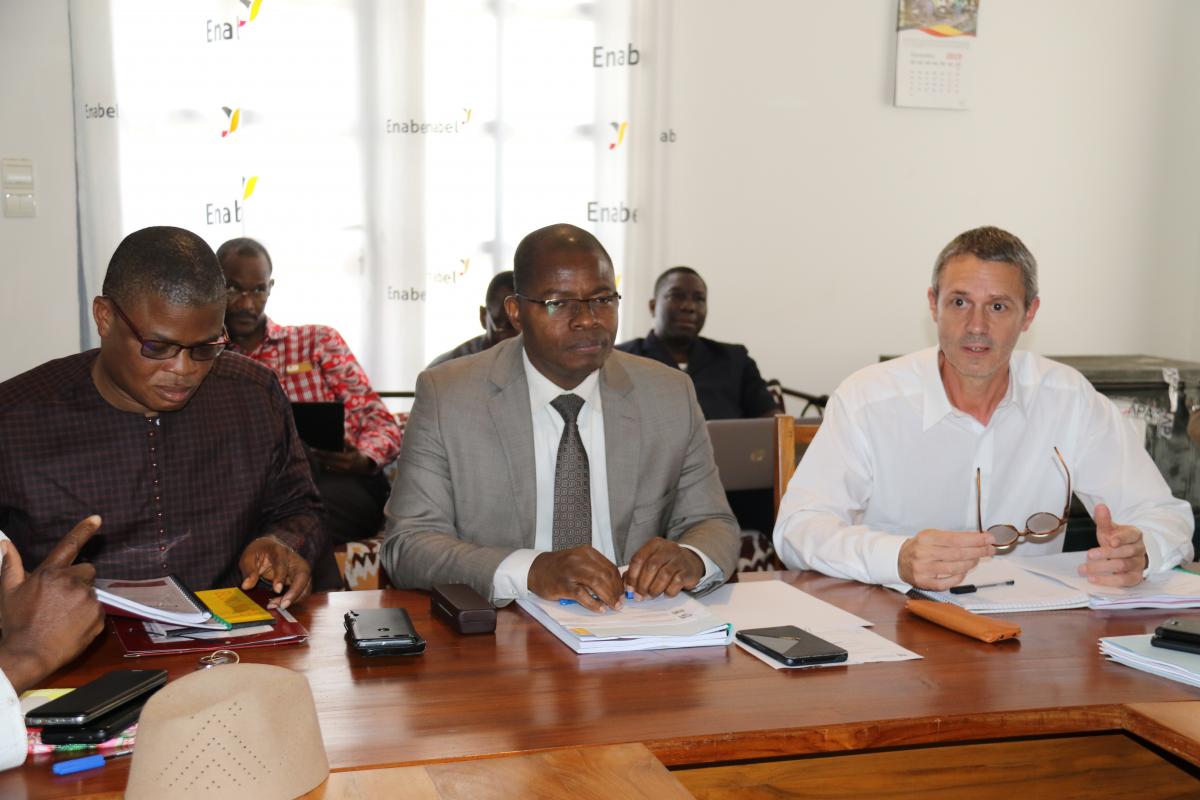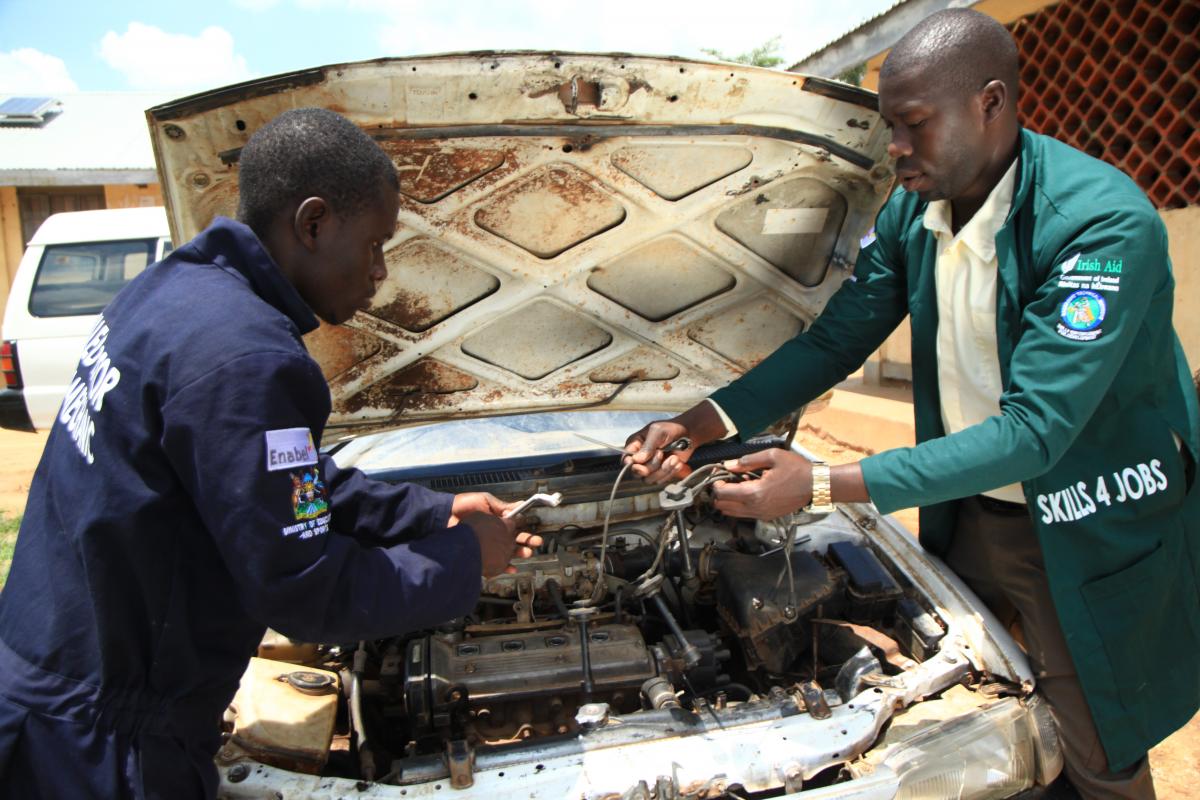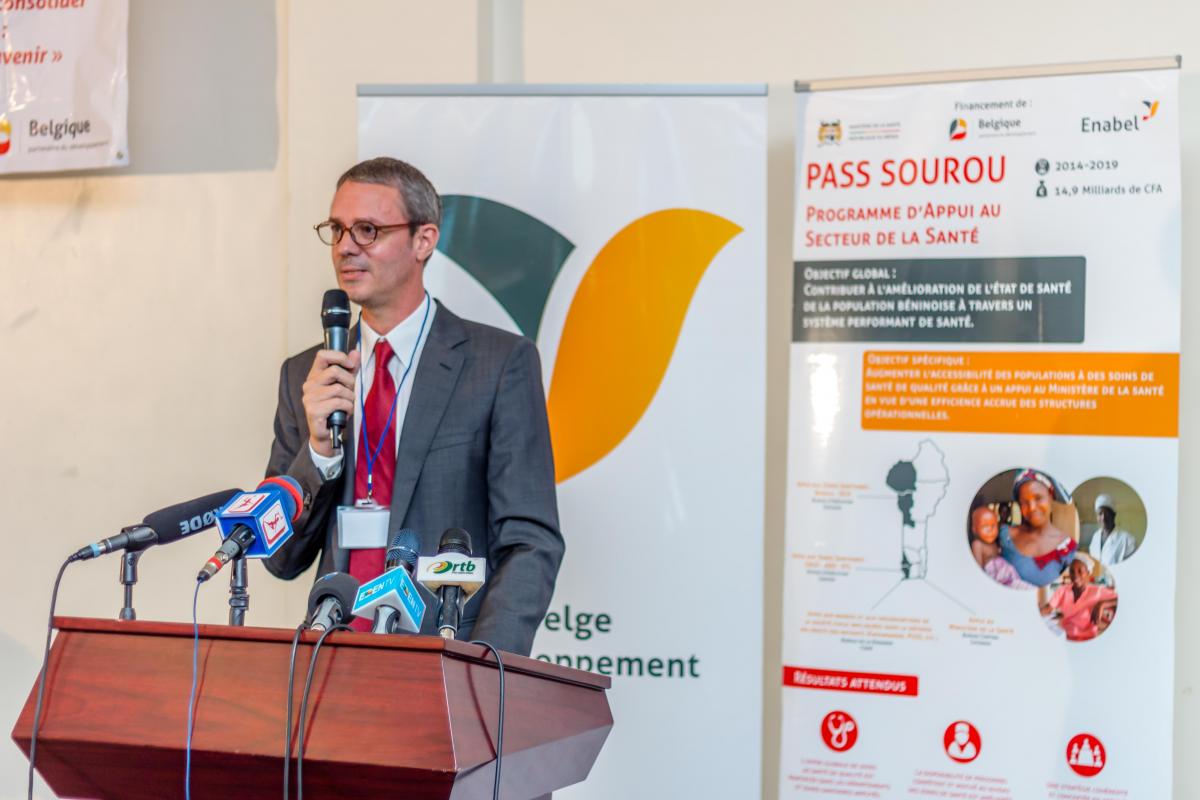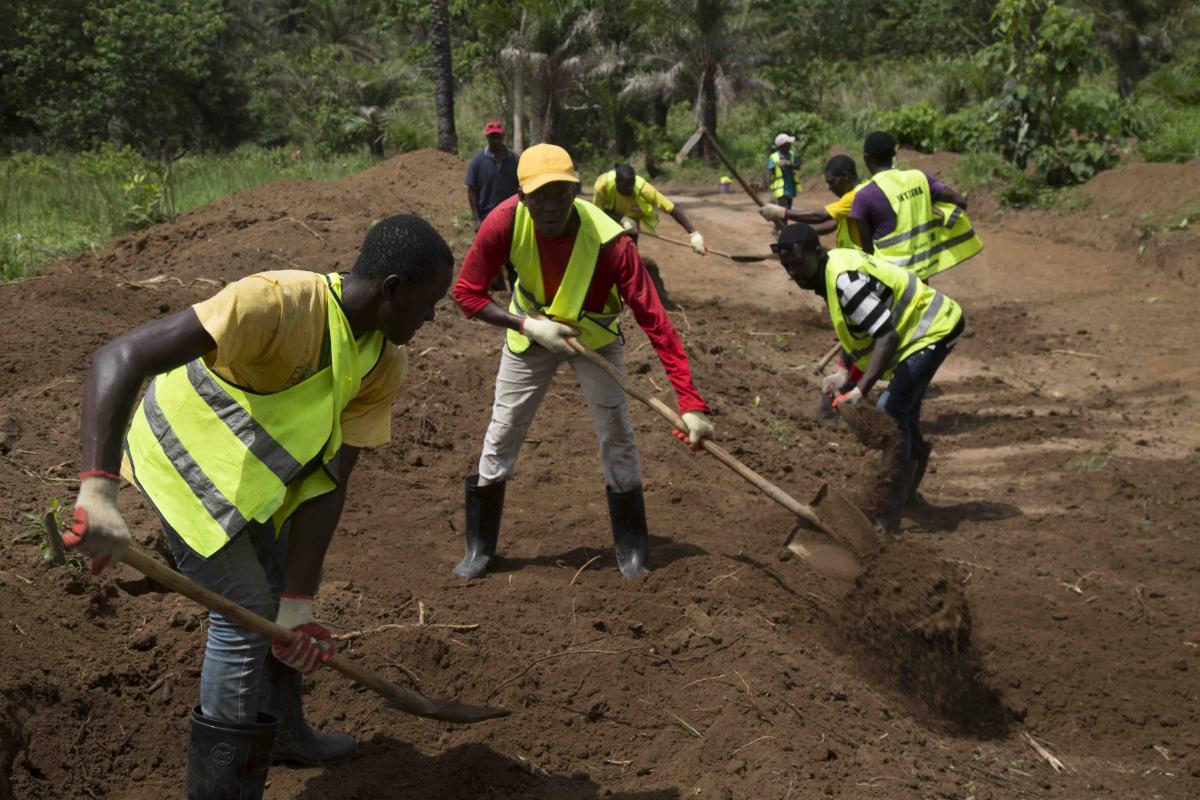Search
Viewing 2235 to 2250 of 3076 news
-
Le Volet institutionnel du PROFI Clôturé Les fondements de l’institution publique clarifiés et repositionnés
Reece-hermine ADANWENON | 30/09/2019
Initié par l’Agence belge de développement « Enabel » au Bénin pour améliorer l’environnement institutionnel en faveur de la promotion des filières agricoles, le volet institutionnel du Programme d’appui au développement des filières agricoles (PROFI-VI) s’achève sur une note de satisfaction. Au cours de la dernière session de la Structure Mixte de Concertation Locale (SMCL), qui s’est tenue le jeudi 26 septembre 2019, dans la salle de réunion de la Représentation de Enabel au Bénin, le rapport final du rapport de l’évaluation finale du programme dans son volet institutionnel a été présenté aux membres. Il ressort des conclusions dudit rapport que le PROFI VI a, entre autres résultats, accompagné les départements et services (centraux et déconcentrés) dans la mise en œuvre des fonctions qui leur sont dévolues.Conduite par Jean Sébastien CANALS, Ingénieur agro-économiste, Chef de mission, Paul Onibon, Ingénieur agronome du Cabinet Analysis for Economic Decisions - ADE s.a., la mission d’évaluation du Programme PROFI volet institutionnel a fait observer que la stratégie développée par le PROFI-VI et Enabel en concertation avec les autorités locales a été particulièrement pertinente, mise en œuvre avec efficacité et efficience et les résultats et impacts sont connus et reconnus à de nombreux niveaux. Il ressort également de l’analyse du programme au regard des 5 critères CAD (Coopération Au Développement) à savoir : la pertinence ; l’efficacité, l’efficience, l’impact et la durabilité (viabilité) que la grande majorité des résultats ont été atteints et ont concouru à l’objectif global du projet. Selon les évaluateurs, le PROFI VI est un programme qui a contribué à : clarifier et repositionner les fondements d’une institution publique, accompagner les départements et services (centraux et déconcentrés) dans la miseen œuvre des missions qui leur sont dévolues, définir les profils de postes des principaux cadres, proposer/former/accompagner la mise en place de nouvelles méthodes, outils deprogrammation/planification/budgétisation/suivi permettant ainsi à la structure d’être plusperformante, de mieux comprendre et mettre en œuvre les réformes et nouveaux paradigmes avec pour objectif le développement et le renforcement des filières comme pilier de la nouvelle politique agricole. Par ailleurs, la mission a recommandé au Ministère de l’Agriculture de l’Elevage et de la Pêche (MAEP) : - d’apporter une attention toute particulière à la coordination entre les niveaux et lesacteurs d‘autant que le niveau central est depuis peu appuyé par un bureau d‘études européen qui a gagné l’appel d’offre lancé par l’UE et le niveau déconcentré par une coopération déléguée bilatérale (Enabel) ; - d’utiliser à bon escient les méthodes et outils qui ont été produits par le PROFI-VI et éviter de recréer de nouveaux outils qui viendraient engendrer de la confusion.- concernant les PSNF, de prévoir leur formation et recyclage sur les méthodes etOutils définis par le niveau central (MAEP) p.e. le Conseil Agricole. À Enabel et ses projets/programmes du secteur agricole, la mission recommande de : - Tenir compte dans leurs interventions des équilibres à respecter entre appuis aux filières d‘export et Sécurité Alimentaire & Nutritionnelle ;- Clarifier les périmètres d’intervention du projet ARISA-B et renforcer les maillons faibles du dispositif sur les outils non encore appropriés et maitrisés. Il a été fait remarqué avec un point d’attention spécifique, que les femmes sont trop peu présentes dans toutes les institutions publiques ou Agence Nationales Etatiques notamment au niveau méso et macro. Les évaluateurs recommandent à ce propos la mise en place d’une vraie politique en la matière. Comme résultats obtenus, le rapport a fait observer que le PROFI-VI s’est engagé au côté du MAEP et de ses services techniques centraux dont la Direction de la Prospective et de la Programmation (DPP), pour l’atteinte des principaux résultats que sont :• Renforcement des capacités du MAEP et ses agences centrales, à travers notamment: (i) l’élaboration et l’adoption des instruments de politiques/stratégies (Plan Stratégique de Développement du Secteur Agricole / Plan National d’investissement Agricole, de Sécurité Alimentaire et Nutritionnelle, cadre programmatique, stratégie de promotion des filières, guide changement climatique, avant-projet de loi sur l’Interprofession), (ii) les outils de planification, de suivi et de coordination (collecte digitalisée de données), (iii) l’appui au processus d’opérationnalisation de l’Agence pour la Sécurité Sanitaire des Aliments, (iv) l’élaboration d’un mécanisme de suivi dans le cadre de l’appui à l’opérationnalisation du Fonds de Développement des Communes affecté à l’Agriculture et accompagnement des 12 Comités Départementaux d’Analyse et de Validation pour la sélection des Investissements communaux structurants pour les filières agricoles, et (v) l’accompagnement du Fonds National de Développement Agricole dans le nouveau contexte institutionnel. • Renforcement des capacités des structures déconcentrées du MAEP, à travers notamment : (i) l’accompagnement de la mise en place des nouvelles Directions Départementales de l’Agriculture, de l’Elevage et de la Pêche et des Agences Territoriales de Développement Agricole (définition postes et profils, internalisation du décret organique, élaboration des Plans de Travail Annuel Budgétisé) ; (ii) des formations sur la Gestion Axée sur les Résultats de Développement ; (iii) l’élaboration de Plans Régionaux de Développement des Filières intégrant l’outil cluster puis, d’un mécanisme de coordination et suivi des nouveaux Programmes Nationaux de Développement des Filières; (iv) la création de Noyaux de Formateurs par thématiques sur le conseil agricole , ainsi que (v) le développement des outils et guides pour en faciliter l’appropriation. • Renforcement des capacités des Acteurs Non Etatiques et des Chambres d’Agricultures du Bénin, à travers notamment l’organisation de sessions de formation sur : (i) la construction d’avis sur les politiques agricoles ; (ii) la veille informative aux questions urgentes du secteur ; (iv) la conception et la mise en œuvre de processus de plaidoyer ; (v) la veille et le contrôle citoyen ; (vi) la gestion axée sur les résultats. Soulignons qu’au cours de cette session de la SMCL, le point des recommandations formulées lors de la SMCL du 19 février 2019 a été présentée. On note que sur 12 recommandations, 09 ont été entièrement exécutées pour un taux de 75% et 03 sont en cours d’exécution pour un taux de 25 %.
-

The Continuous School Practice Pilot System
Dorothy KYAMAZIMA | 30/09/2019
While school practice is something that exists in the teaching profession, it is usually something that teacher trainees get very little or no experience of unless in the form of an examination scheduled in the study curriculum known as Examination School Practice. This version of the school practice happens at the end of each year and teacher trainees are graded on their practical teaching skills which they only get to rehearse for the very first time in an actual classroom. Something that the majority of the teacher trainees are not prepared for. This is why Enabel’s Teacher Training Education (TTE) project has introduced a pilot system known as Continuous School Practice that provides teacher trainees with more opportunities to practice their teaching methods and improve their skills before they take on their final Examination School Practice making them better-qualified teachers.
-

ICT in Teaching and Learning
Dorothy KYAMAZIMA | 29/09/2019
Enabel through the Teacher Training Education Project aims at improving the quality of education by strengthening professional competencies of teacher trainers and future teachers graduating from the National Teachers' Colleges in Uganda. Among its focus is the inclusion of ICT in Teaching and Learning.
-

ICT in Teaching and Learning
Dorothy KYAMAZIMA | 29/09/2019
Enabel through the Teacher Training Education Project aims at improving the quality of education by strengthening professional competencies of teacher trainers and future teachers graduating from the National Teachers' Colleges in Uganda. Among its focus is the inclusion of ICT in Teaching and Learning.
-

ICT in Teaching and Learning
Dorothy KYAMAZIMA | 29/09/2019
Enabel through the Teacher Training Education Project aims at improving the quality of education by strengthening professional competencies of teacher trainers and future teachers graduating from the National Teachers' Colleges in Uganda. Among its focus is the inclusion of ICT in Teaching and Learning.
-

ICT in Teaching and Learning
Dorothy KYAMAZIMA | 29/09/2019
Enabel through the Teacher Training Education Project aims at improving the quality of education by strengthening professional competencies of teacher trainers and future teachers graduating from the National Teachers' Colleges in Uganda. Among its focus is the inclusion of ICT in Teaching and Learning.
-

ICT in Teaching and Learning
Dorothy KYAMAZIMA | 29/09/2019
Enabel through the Teacher Training Education Project aims at improving the quality of education by strengthening professional competencies of teacher trainers and future teachers graduating from the National Teachers' Colleges in Uganda. Among its focus is the inclusion of ICT in Teaching and Learning.
-
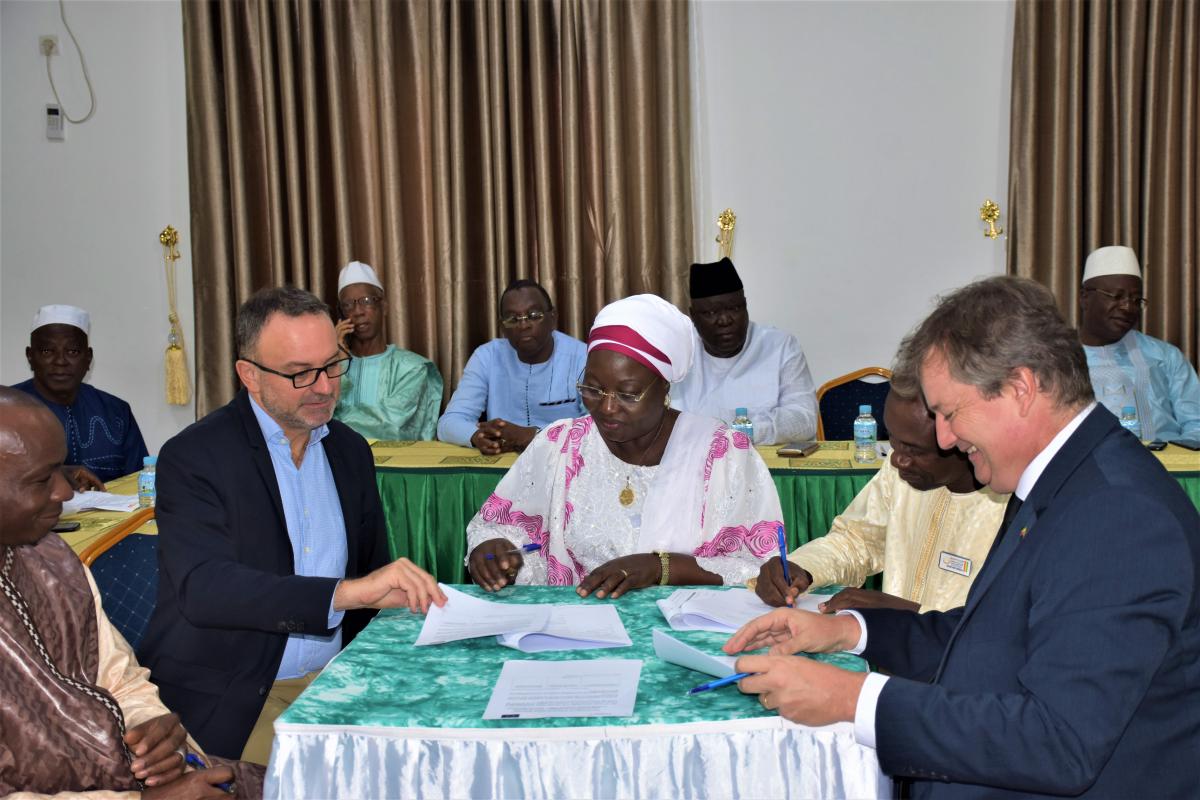
Signature d'accords de partenariats entre Sanita Villes Propres et les différentes communes de Conakry .
Djene Deen KOUYATE | 27/09/2019
Ce Vendredi 21 septembre 2019, Enabel à travers Sanita Villes propres financé dans le cadre du 11ème Fond Européen de développement de l’Union européenne a procédé à la signature des accords de partenariats avec les cinq (5) communes de la ville de Conakry. Le premier objectif est de permettre aux communes et Sanita de formaliser leurs partenariats, le second consiste à renforcer les capacités institutionnelles des communes par la remise de dotations en matériels roulants (2 motos par commune) et d’outils informatiques (ordinateurs et imprimantes) pour la mise en œuvre efficace des activités de gestion des déchets. Cette rencontre a été mise à profit pour présenter les grands chantiers en perspectives et en cours du programme Sanita Villes propres aux différents maires notamment l’appui à la maitrise d’ouvrage des communes pour la professionnalisation de la gestion des déchets solides au sein des ménages, marchés, plages etc.… La question de sécurisation foncière des infrastructures d’assainissement en cours de construction (Zone de transit et de tri), ainsi que l’évaluation des PME étaient à l’ordre du jour. A cette occasion, M. François Kieffer country Portfolio manager Enabel a présenté l’agence belge de développement nouvellement installée en Guinée, en étalant les objectifs et activités des programmes en exécution (Sanita Villes propres, Intégra, bilatéral …) et les domaines d’interventions de l’agence. Il a aussi réaffirmé l’engagement de Sanita Villes propres à apporter une expertise conséquente pour une meilleure approche moderne de professionnalisation du secteur d’assainissement. A son tour au nom des différentes communes Mme Camara Aminata Touré Maire de la commune de Kaloum a réitéré leur engagement à porter un intérêt particulier aux appuis de Sanita Villes propres pour l’assainissement durable des communes. La cérémonie s’est conclue par la signature des accords et la remise des équipements fournis avec le financement de L’Union européenne.
-
FROM STUDENT TO TEACHER – the story of Odong Andrew technical instructor in Nakapiripirit Technical institute.
Joseph BASOGA | 27/09/2019
For bible believers the writing is on the wall in provers 22;229“Do you see someone diligent and skilled in their work? They will serve before kings; they will not serve before officials of low rank.” It is this kind of text that inspired Odongo Andrew, 27, from Omito Parish in Lira to become the good instructor. Born in an impoverished family of 7 children with parents who survived om brewing local potent-gincodenamed Waragi, Odong was forced to quit school in Primary seven. Few months after quitting, he joined Latodi company as construction “porter” (a worker whose only job is to take instruction on the various chores signed by the constructor). His only Pay then was UGX 4500 ($1.5) and plate of posho and beans per day. Even with his meager resource, Odong could save half a dollar and with time he made his first capital that was to act as his first school fees.He borrowed a small mattress from his brother and made sojourn to the catholic diocese in Lira where a one father Bentino offered him a job as “spanner boy” helping out in the garage. He worked here for 3 years until Bentino gave him UGX 600, 000 ($200) as token of appreciation. This money was perhaps the start of a long journey to skilling but he confesses it was never enough to study his dream course. He then enrolled at Kiryandongo for a craft one course but continued to work as a part-time casual laborer until he finished school. It is at time that Enabel Supported by Irish aid offered to provide support to skilling young Karamajongs. Odong was approached by the deputy principle of the Vocational institute in Nakapiripirit, Okwir Benson who later registered him as one of the 25 pioneer Moto vehicle training students under the sponsorship of Enabel. True to his determination Odong was the only who passed National Exams. AK Mukwano plastics provided opportunity for internship and was paying at least UGX 200,000 per month. “This raise came as result of training. Thanks to Enabel” he says with an explicit smile on his face. The skilling and pay also promoted him to becoming a mechanic at Wimble garage in Lira, from where he upgraded to an instructor’s course at the National Instructors’ college in Abino-nino. Odong has not forgotten his roots, he back where his talent was made at the Nakapiripirit vocational institute where he serves instructor for Moto vehicle Technology and acts institute mechanic. He provided advise to all those who seem frustrated by pressure of life with five attributes for success.1. Accept who you are 2. Do not consider your background you have the power to change your future3. Be creative and innovative 4. Be disciplined 5. Be innovative
-
Clôture du Programme d’Appui au Secteur de la Santé (PASS-Sourou) Le Maintien des acquis au cœur des échanges
Reece-hermine ADANWENON | 26/09/2019
L’ensemble des acteurs du système sanitaire du Bénin est réuni depuis la matinée de ce Jeudi 26 septembre 2019, à l’Hôtel Azalaï de Cotonou. Objectif de cette rencontre : - s'approprier les principales actions et performances atteintes dans le cadre de la mise en œuvre du Programme d’Appui au Secteur de la Santé (PASS-Sourou) ; - analyser les stratégies et expériences développées par ledit programme ;- appréhender les défis pour le secteur et de- Synthétiser les acquis pertinents à pérenniser.Initié par l’Agence belge de développement « Enabel au Bénin » depuis 05 ans, le Programme PASS Sourou, sous la guidance du Secrétariat Général du Ministère de la Santé et ensemble avec les acteurs de tous les niveaux de la pyramide sanitaire, a dans une harmonieuse approche de cogestion, patiemment, difficilement parfois, mais toujours avec persévérance, appuyé, facilité des processus et initié des actions dans de nombreux domaines en ligne avec les axes prioritaires du Plan National de Développement Sanitaire (PNDS). Inscrit dans une dynamique réflexive de recherche, action et capitalisation, l’atelier de partage des expériences du PASS permet de donner un signal fort pour tirer les leçons des expériences afin de consolider les interventions en santé pour l’avenir. Dans son mot de bienvenue, le Coordonnateur du PASS, Dr Elysée SOMASSE n’a pas manqué de remercier et de féliciter tous les acteurs du système sanitaire qui ont œuvré à la mise en œuvre du programme et surtout qui ont contribué efficacement à l’atteinte des résultats assignés. Pour lui cet atelier offre l’occasion de faire une revue des expériences développées en cinq années, de célébrer les succès mais aussi d’analyser les défis qui restent à relever. Pour Mélanie SCHELLENS, chef de la Coopération à l’Ambassade de Belgique près le Bénin, la coopération entre le Bénin et la République du Bénin s’est construite au fil des années avec ‘Sourou’, c’est-à-dire patience et persévérance, mais aussi avec efficacité, et se traduit par de nombreuses réalisations concrètes au profit des populations béninoises. L’amélioration continue de la qualité des soins et services, le développement des ressources humaines en santé, la redevabilité sociale, l’accessibilité à une offre de soins obstétricaux néonataux d’urgence (SONU) de qualité, la prévention et le contrôle des maladies chroniques non-transmissibles, la maintenance des infrastructures et des équipements, les services conviviaux de santé sexuelle et reproductive aux adolescents et jeunes, l’utilisation de l’information sanitaires de qualité pour la prise de décision sont autant de domaines qui ont bénéficié avec succès du soutien technique et financier du PASS Sourou.« Pendant que le PASS Sourou est en train de se terminer, les produits qui sortiront de ces réflexions permettront d’écrire les dernières belles pages de ce programme, pages d’enseignements qui poseront le fondement pour la pérennisation de ses acquis et contribueront à renforcer le système de santé du Bénin » a déclaré M. Jean-François MICHEL, représentant Résident de Enabel au Bénin. Selon lui, cet atelier de partage est le creuset pour inviter tous les acteurs à un exercice pragmatique et sans concession. A ce propos, Jean-François MICHEL reste confiant et garde espoir que de riches enseignements émaneront de l’atelier de partage, et serviront d’intrants aux réformes en cours pour assurer l’accès de tous les citoyens béninois aux soins de santé de qualité.Représentant le Ministre de la Santé à la cérémonie d’ouverture, Dr Didier AGOSSADOU, Secrétaire Général du Ministère de la Santé dira que le PASS-Sourou a accompagné les cinq domaines stratégiques du Plan National de Développement Sanitaire (PNDS). Il a souligné les performances réalisées au travers de ses principales composantes à savoir : - la démarche qualité des soins développée et pratiquée dans 43 formations sanitaires pour les préparer au volet assurance maladie de l’ARCH.- la prise en charge intégrée, promotionnelle, préventive et curative des maladies non transmissibles (MNT) dans les 5 Zones Sanitaires - la couverture des soins obstétricaux et néonataux d’urgence de base (SONUB) et les soins obstétricaux et néonataux d’urgence complets (SONUC) - l’amélioration du système de référence et de contre-référence (RCR) avec entre autres, la mise à disposition du ministère de dix (10) ambulances médicalisées- la promotion des cadres de redevabilité notamment les PUSS dont les expériences sont capitalisées à travers le projet de gestion des plaintes des usagers initiés par le cabinet du Secrétariat appelé « je t’écoute ». - l’amélioration de la formation et de la gestion des RHS à travers la construction de l’IFSIO à Parakou et la réhabilitation de l’INMES de Cotonou puis la mise en place du logiciel IHRIS - l’amélioration du système de maintenancePour Dr Didier AGOSSADOU, ce bilan sommaire met en évidence non seulement un excellent alignement sur les priorités nationales mais aussi sur l’approche systémique de l’appui du partenaire belge. Aussi l’ancrage au sein des structures pérennes du ministère offre-t-il un potentiel de durabilité des acquis, a-t-il indiqué. Par ailleurs, il a martelé que la coopération entre la République du Bénin et le Royaume de Belgique a, depuis des décennies, épousé et conservé un caractère exemplaire, eu égard à toutes les réalisations faites avec l'appui dudit partenaire.
-
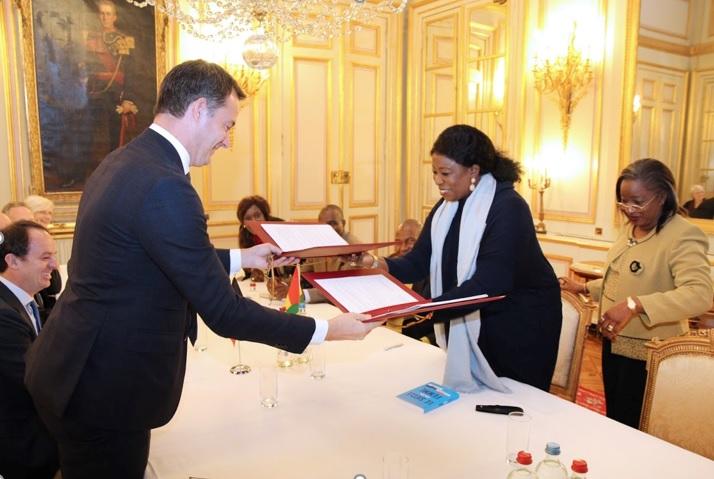
Signature de la convention du nouveau portefeuille Guinée 2019-2023
Cindy SPIEKART | 25/09/2019
Signature de la convention du nouveau portefeuille Guinée 2019-2023
-

Projet d'approvisionnement en eau potable
Djene Deen KOUYATE | 20/09/2019
Projet d'approvisionnement en eau potable
-
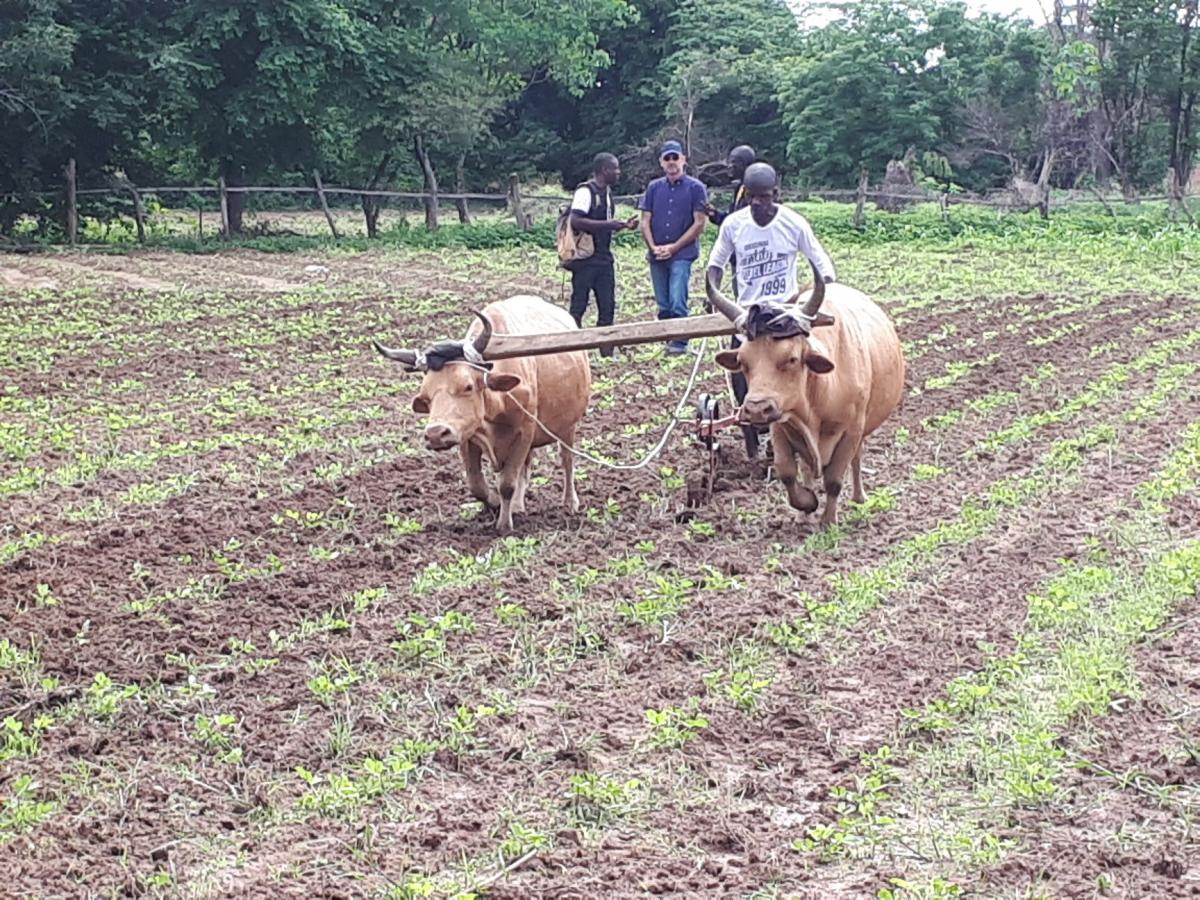
DAKMA
Djene Deen KOUYATE | 20/09/2019
Appui au développement agricole dans la zone de Kindia-Mamou - DAKMA
-
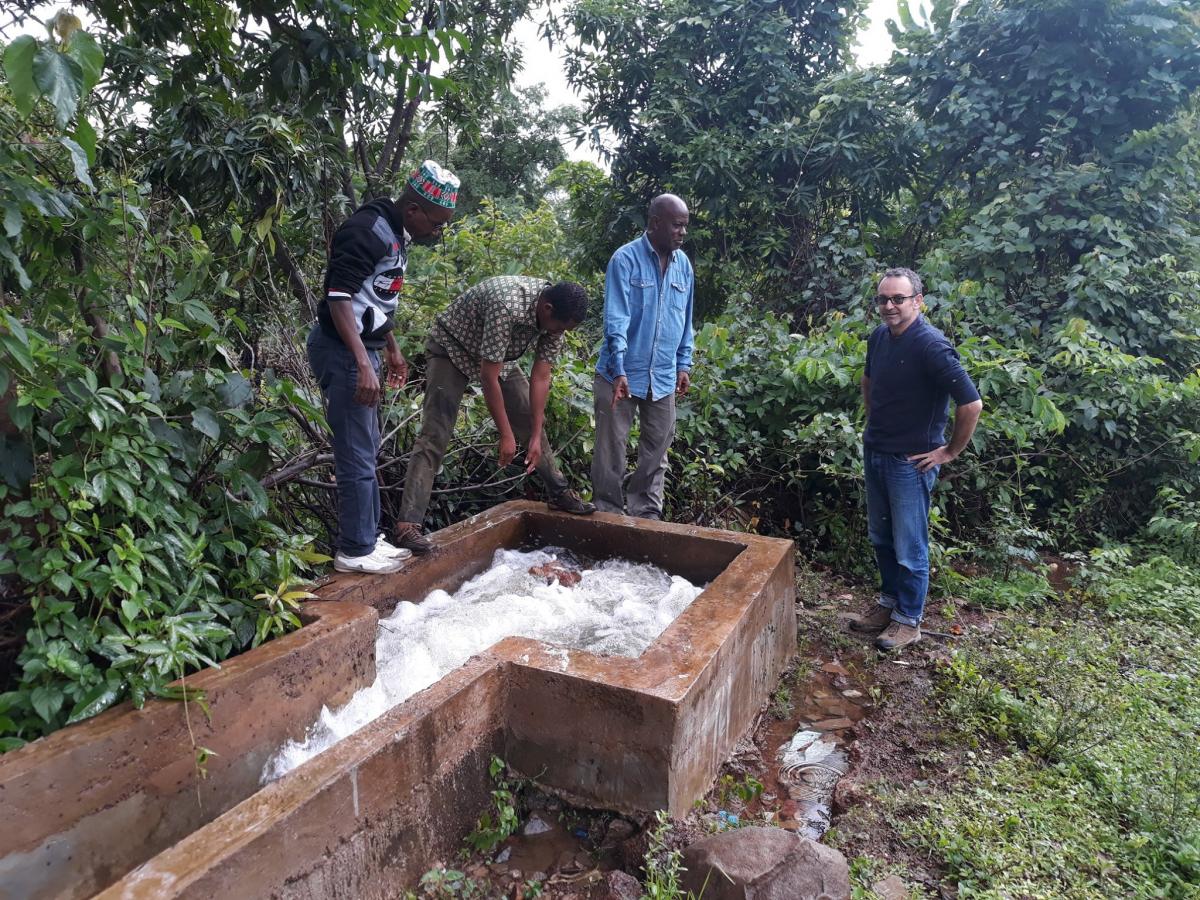
Projet d'approvisionnement en eau potable
Djene Deen KOUYATE | 20/09/2019
Projet d'approvisionnement en eau potable
-
Les jeunes bénéficiaires du programme INTEGRA en Chantier-école sur la piste de Badarayah à KIndia
Djene Deen KOUYATE | 20/09/2019
A l'issu de la pré-identification à Badarayah des futurs apprenants menée par les agents d'Enabel et du Ministère de la Jeunesse et de Emplois Jeunes (sensibilisation des communautés de Badarayah sur les risques de la #migrationirrégulière, information sur le programme #INTEGRA, les missions d'INTEGRA Enabel à Badarayah ) , plus de 150 jeunes bénéficiaires du programme effectuent depuis plusieurs mois , leur formation chantier-école sur la piste rurale de Badarayah . Ils participent à la réalisation d'infrastructures socio-économiques au niveau local .Intégra est le programme d'insertion socio-économique des jeunes qui vise à créer des opportunités d'emplois pour les jeunes afin de leur permettre de réussir en Guinée .
